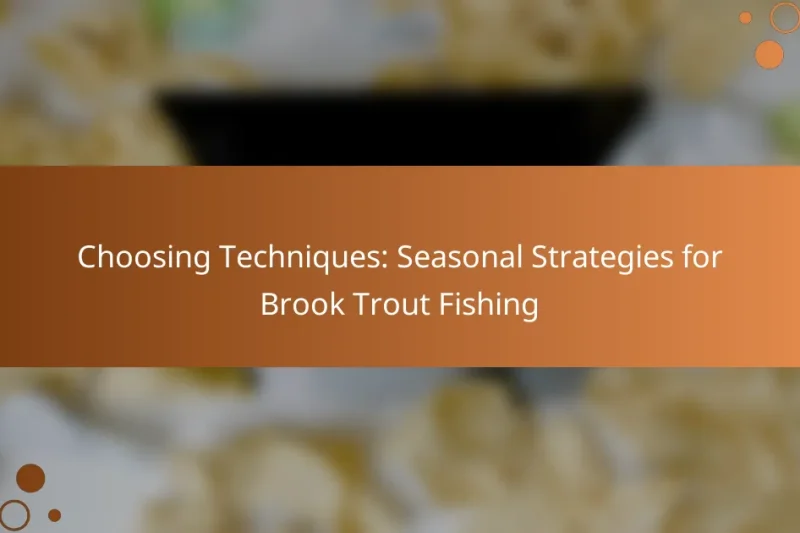Catching brook trout in cold weather requires specific techniques and tackle choices tailored to their behavior … Catching Brook Trout: Cold Weather Techniques and Tackle ChoicesRead more
Brook Trout Fishing Techniques
Brook Trout fishing offers a rewarding experience for anglers, with various techniques such as fly fishing, spin fishing, and bait fishing available to suit different preferences. Targeting these fish in cold, clean waters rich in cover and food sources enhances your chances of success. With the right equipment and knowledge of prime locations, you can enjoy a fruitful day on the water.
Catch and Release Techniques: Brook Trout and Other Species Comparison
Catch and release techniques are essential for preserving fish populations, particularly for species like brook trout, … Catch and Release Techniques: Brook Trout and Other Species ComparisonRead more
Trolling Techniques: Large Reservoir Strategies for Brook Trout
Trolling for brook trout in large reservoirs requires specialized techniques to enhance success. Utilizing tools like … Trolling Techniques: Large Reservoir Strategies for Brook TroutRead more
Bait Techniques: Effective Options for Brook Trout in Lakes
When targeting brook trout in lakes, employing effective bait techniques is crucial for success. Options such … Bait Techniques: Effective Options for Brook Trout in LakesRead more
Spinning Gear Techniques: Mountain Stream Strategies and Bait Options
Mastering spinning gear techniques in mountain streams is essential for successful fishing, as it involves precise … Spinning Gear Techniques: Mountain Stream Strategies and Bait OptionsRead more
Choosing Techniques: Seasonal Strategies for Brook Trout Fishing
Choosing the right techniques for brook trout fishing requires an understanding of seasonal changes and how … Choosing Techniques: Seasonal Strategies for Brook Trout FishingRead more
Fly Fishing Techniques: Freshwater Methods, Gear Selection and Casting Skills
Fly fishing in freshwater offers a diverse range of techniques, including dry fly fishing, nymph fishing, … Fly Fishing Techniques: Freshwater Methods, Gear Selection and Casting SkillsRead more
What are effective Brook Trout fishing techniques?
Effective Brook Trout fishing techniques include fly fishing with dry flies, spin fishing with lures, and bait fishing with worms. Each method has its own advantages and considerations, allowing anglers to choose based on their skills and the fishing environment.
Fly fishing with dry flies
Fly fishing with dry flies is a popular method for catching Brook Trout, especially in streams and rivers where these fish feed on insects. This technique involves casting lightweight flies that float on the water’s surface, mimicking natural insects.
To be successful, choose flies that match the local insect hatch, and use a 4 to 6 weight rod with a floating line. Pay attention to the water’s surface for rising fish, and practice your casting to improve accuracy.
Spin fishing with lures
Spin fishing with lures is another effective technique for targeting Brook Trout, particularly in lakes and larger rivers. This method involves using spinning reels and various lures such as spoons, spinners, or crankbaits to entice fish.
When selecting lures, opt for smaller sizes, typically ranging from 1 to 3 inches, in bright colors or natural patterns. Retrieve the lure at varying speeds to find what triggers strikes, and be mindful of local regulations regarding lure types.
Bait fishing with worms
Bait fishing with worms is a straightforward and effective approach for catching Brook Trout, especially for beginners. Nightcrawlers or red worms are popular choices, as they are readily available and highly attractive to fish.
Use a simple rig with a hook and a small weight to keep the bait near the bottom or suspended at varying depths. Check local regulations for bait restrictions, and consider using a bobber to help detect bites.
Using catch and release methods
Using catch and release methods is essential for conserving Brook Trout populations. This practice allows anglers to enjoy fishing while ensuring that fish can continue to thrive in their habitats.
When practicing catch and release, handle fish gently, wet your hands before touching them, and use barbless hooks to minimize injury. Quickly remove the hook and return the fish to the water to increase its chances of survival.
Where are the best locations for Brook Trout fishing?
The best locations for Brook Trout fishing typically include cold, clean waters with plenty of cover and food sources. Mountain streams, lakes in the Rocky Mountains, and cold rivers in New England are prime spots for anglers seeking this species.
Mountain streams in the Appalachian region
Mountain streams in the Appalachian region are renowned for their clear, cold waters, which provide an ideal habitat for Brook Trout. These streams often feature rocky bottoms and abundant vegetation, creating excellent cover for fish.
When fishing in these streams, focus on areas with riffles and pools, as Brook Trout tend to hide in the current and ambush prey. Early morning or late evening are the best times to fish, as the trout are more active during these cooler hours.
Lakes in the Rocky Mountains
Lakes in the Rocky Mountains offer a different fishing experience for Brook Trout, often featuring deeper waters and varied structures. These lakes can be accessed via hiking trails, making them less crowded and more appealing to anglers seeking solitude.
When targeting Brook Trout in these lakes, consider using floating or sinking lines with streamers or nymphs. Fishing near the shoreline or around submerged structures can yield good results, especially during the warmer months when trout move closer to the surface.
Cold rivers in New England
Cold rivers in New England are another excellent location for Brook Trout fishing, characterized by their swift currents and cool temperatures. These rivers often have a diverse ecosystem, providing ample food sources for the trout.
To effectively fish these rivers, use techniques such as dry fly fishing or nymphing, particularly in areas with slower currents or eddies. Pay attention to local regulations, as some rivers may have specific rules regarding fishing seasons and catch limits.
What equipment is needed for Brook Trout fishing?
To successfully fish for Brook Trout, you will need a combination of lightweight fishing rods, suitable reels, and specific flies or lures. Each piece of equipment plays a crucial role in enhancing your fishing experience and improving your chances of catching these fish.
Lightweight fishing rods
Lightweight fishing rods are essential for Brook Trout fishing as they provide better sensitivity and control. A rod length of around 6 to 7 feet is typically ideal, allowing for precise casting in various water conditions.
When selecting a rod, consider materials such as graphite or fiberglass, which offer a good balance of strength and flexibility. Look for a rod rated for light to ultralight action, which will help you feel even the slightest nibble.
Reels suitable for freshwater
For Brook Trout fishing, a spinning reel is often the best choice due to its versatility and ease of use. Choose a reel that is lightweight and has a smooth drag system, which is crucial for handling the quick movements of these fish.
Reel sizes in the 1000 to 2500 range are generally appropriate for freshwater fishing. Ensure that the reel is compatible with your rod and can handle the line weight you plan to use, typically between 4 to 8 pounds for Brook Trout.
Flies and lures specific to Brook Trout
Using flies and lures that mimic the natural diet of Brook Trout can significantly increase your chances of success. Popular fly patterns include Adams, Elk Hair Caddis, and Woolly Bugger, which imitate insects and small fish.
When it comes to lures, spinners and spoons in sizes ranging from 1/16 to 1/4 ounce work well. Bright colors can attract attention, especially in murky waters, while more natural hues are effective in clear streams.
How to choose the right bait for Brook Trout?
Choosing the right bait for brook trout is crucial for a successful fishing experience. Live bait and artificial lures both have their advantages, and the best choice often depends on the specific fishing conditions and personal preference.
Live bait like worms and minnows
Live bait, such as worms and minnows, is highly effective for attracting brook trout. These natural food sources mimic the trout’s typical diet, making them more appealing. When using live bait, ensure it is fresh and properly hooked to enhance movement in the water.
Consider using nightcrawlers or small minnows, as they are particularly enticing. A common technique is to use a slip sinker rig, allowing the bait to move freely while staying close to the bottom where brook trout often feed.
Artificial lures that mimic natural prey
Artificial lures can be just as effective as live bait when targeting brook trout. Lures that mimic the appearance and movement of natural prey, such as small fish or insects, can trigger aggressive strikes. Popular options include spinners, spoons, and soft plastics.
When selecting artificial lures, consider the water conditions and the time of year. For example, during spring, bright colors may work well, while more subdued tones might be better in clear water. Experimenting with different retrieval speeds can also help determine what the fish prefer on a given day.
What are the seasonal patterns for Brook Trout fishing?
Brook Trout fishing is influenced by seasonal patterns that dictate their behavior and habitat preferences. Understanding these patterns can significantly enhance your fishing success throughout the year.
Spring spawning behavior
In spring, Brook Trout engage in spawning, typically from late March to early May, depending on water temperatures. During this period, they migrate to shallow, gravel-bottomed streams and rivers to lay their eggs. Anglers should focus on these spawning areas, as fish are more concentrated and can be caught using small, natural baits.
It is crucial to practice catch and release during the spawning season to protect the population. Avoid fishing directly in spawning beds to minimize disturbance and ensure the sustainability of the fishery.
Summer feeding habits
As water temperatures rise in summer, Brook Trout tend to move to cooler, deeper waters. They become more active during early mornings and late evenings when temperatures are lower. During this season, using small spinners or dry flies can be effective, particularly in shaded areas or near underwater structures.
Pay attention to insect hatches, as Brook Trout often feed on emerging insects. Matching your fly or bait to the local hatch can significantly improve your chances of success.
Fall migration patterns
In fall, Brook Trout begin to migrate back to their spawning grounds as water temperatures drop. This migration typically occurs from late September to November. Anglers can find them in rivers and streams, often in larger schools, making this a prime time for fishing.
Using larger streamers or spoons can be effective during this period, as fish are preparing for the winter. Be mindful of local regulations regarding fishing during the migration season to ensure compliance and conservation of the species.






